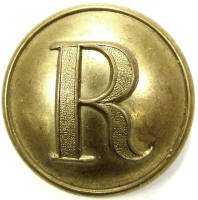
A virtual examination of artifacts of the American Civil War
 | Ridgeway Civil War Research Center,
A virtual examination of artifacts of the American Civil War |
| Civil War Artillery | |
| by Harry Ridgeway |
| Rifled artillery projectile, Parrott design, Federal manufacture, bursting shell, pattern with flat bottom, high band brass sabot experimental pattern without fuze, rifled 42 pounder rifle, 7in. Projectile was manufactured in the Federal arsenals following development of Parrott's patent. The 7 inch guns in the Federal arsenal were modified to add rifling and areinforcement band, the idea being to accommodate the equivalent of a double smoothbore shot, hence the smoothbore 42 pounder became a "rifled 42 pounder". This 7 inch Parrott shell was a prototype to be used in the converted smoothbore guns, subsequent development was for the rifled series of Parrott guns, hence use of this weapon is limited. The small wood fuze hole suggests that this round may have been a test round, they are found at West Point, but others have also been found in Charleston, South Carolina, all missing sabots and may have also been tested at Fort Sumter. Shell was cast with a cavity and a fuze hole, but the fuze hole was never drilled or threaded to take a fuze. Sabot is missing, none of the Charleston shells have been recovered with sabot, so we do not know which type of sabot was actually employed, however based on the time of use and shape of the notches, it most likely employed the high band sabot. Shell measures: diameter 6.9in., length 14in., weight 78lbs. (empty and missing sabot). Research Center: Artillery4751-Parrott, Ref: Bell Heavy Ordnance, pg. 305. Details click: http://relicman.com/artillery/Artillery4751-Parrott.html. |
| A2213...Rifled artillery projectile, Parrott design, Federal manufacture, bursting shell, pattern with flat bottom, high band brass sabot experimental pattern without fuze, rifled 42 pounder rifle, 7in.
Projectile was manufactured in the Federal arsenals following development of Parrott's patent. The 7 inch guns in the Federal arsenal were modified to add rifling and a reinforcement band, the idea being to accommodate the equivalent of a double smoothbore shot, hence the smoothbore 42 pounder became a "rifled 42 pounder". This 7 inch Parrott shell was a prototype to be used in the converted smoothbore guns, subsequent development was for the rifled series of Parrott guns, hence use of this weapon is limited. The small wood fuze hole suggests that this round may have been a test round, they are found at West Point, but others have also been found in Charleston, South Carolina, all missing sabots and may have also been tested at Fort Sumter. Shell was cast with a cavity and a fuze hole, but the fuze hole was never drilled or threaded to take a fuze. Sabot is missing, none of the Charleston shells have been recovered with sabot, so we do not know which type of sabot was actually employed, however based on the time of use and shape of the notches, it most likely employed the high band sabot. Shell measures: diameter 6.9in., length 14in., weight 78lbs. (empty and missing sabot). High band sabot was separated on firing. Fuze hole is not threaded or milled. Metal solid. Shell disarmed, open fuze hole exposes empty cavity. Recovered: city of Charleston South Carolina. Fort Sumter in Charleston harbor was equipped with 7 inch guns, mostly using the James series of 7 inch shells, and expended their ammunition against the attacking Confederate batteries in the city. Once Sumter fell to the Confederates, subsequent Federal sieges were out of range of the city and employed the 100 and 200 pounder rifled series of guns, rendering these old smoothbore conversions obsolete, so the only time the Federals could fire into the city seems to have been during the siege of Fort Sumter on day one of the Civil War! Ref: Bell Heavy Ordnance, pg. 305. |
| Ridgeway Civil War Research Center, A virtual examination of artifacts of the American Civil War. Artillery Research center, artillery, click: http://relicman.com/artillery/Artillery0000-Index.html. Research center, artillery, click: http://relicman.com/artillery/Artillery0000-Index.html. |
| Civil War Relicman, Harry Ridgeway, Civil War artillery, Relicman sales catalog. Click here: http://relicman.com/artillery/RelicmanSalesArtillery1.html. Artillery for sale: http://relicman.com/artillery/RelicmanSalesArtillery1.html. |